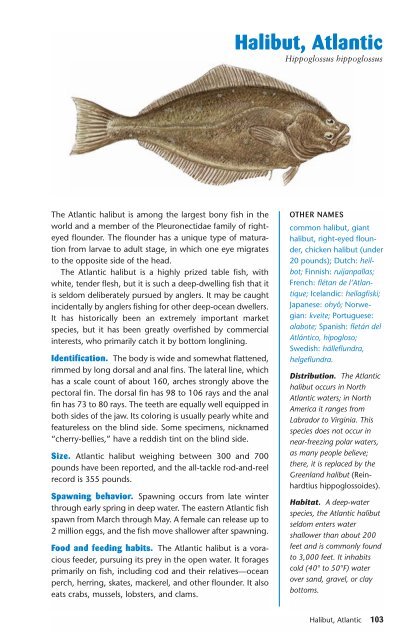Ken Schultz's Field Guide to Saltwater Fish - Macaw Pets store
Ken Schultz's Field Guide to Saltwater Fish - Macaw Pets store
Ken Schultz's Field Guide to Saltwater Fish - Macaw Pets store
Create successful ePaper yourself
Turn your PDF publications into a flip-book with our unique Google optimized e-Paper software.
The Atlantic halibut is among the largest bony fish in the<br />
world and a member of the Pleuronectidae family of righteyed<br />
flounder. The flounder has a unique type of maturation<br />
from larvae <strong>to</strong> adult stage, in which one eye migrates<br />
<strong>to</strong> the opposite side of the head.<br />
The Atlantic halibut is a highly prized table fish, with<br />
white, tender flesh, but it is such a deep-dwelling fish that it<br />
is seldom deliberately pursued by anglers. It may be caught<br />
incidentally by anglers fishing for other deep-ocean dwellers.<br />
It has his<strong>to</strong>rically been an extremely important market<br />
species, but it has been greatly overfished by commercial<br />
interests, who primarily catch it by bot<strong>to</strong>m longlining.<br />
Identification. The body is wide and somewhat flattened,<br />
rimmed by long dorsal and anal fins. The lateral line, which<br />
has a scale count of about 160, arches strongly above the<br />
pec<strong>to</strong>ral fin. The dorsal fin has 98 <strong>to</strong> 106 rays and the anal<br />
fin has 73 <strong>to</strong> 80 rays. The teeth are equally well equipped in<br />
both sides of the jaw. Its coloring is usually pearly white and<br />
featureless on the blind side. Some specimens, nicknamed<br />
“cherry-bellies,” have a reddish tint on the blind side.<br />
Size. Atlantic halibut weighing between 300 and 700<br />
pounds have been reported, and the all-tackle rod-and-reel<br />
record is 355 pounds.<br />
Spawning behavior. Spawning occurs from late winter<br />
through early spring in deep water. The eastern Atlantic fish<br />
spawn from March through May. A female can release up <strong>to</strong><br />
2 million eggs, and the fish move shallower after spawning.<br />
Food and feeding habits. The Atlantic halibut is a voracious<br />
feeder, pursuing its prey in the open water. It forages<br />
primarily on fish, including cod and their relatives—ocean<br />
perch, herring, skates, mackerel, and other flounder. It also<br />
eats crabs, mussels, lobsters, and clams.<br />
Halibut, Atlantic<br />
Hippoglossus hippoglossus<br />
OTHER NAMES<br />
common halibut, giant<br />
halibut, right-eyed flounder,<br />
chicken halibut (under<br />
20 pounds); Dutch: heilbot;<br />
Finnish: ruijanpallas;<br />
French: flétan de l’Atlantique;<br />
Icelandic: heilagfiski;<br />
Japanese: ohyô; Norwegian:<br />
kveite; Portuguese:<br />
alabote; Spanish: fletán del<br />
Atlántico, hipogloso;<br />
Swedish: hälleflundra,<br />
helgeflundra.<br />
Distribution. The Atlantic<br />
halibut occurs in North<br />
Atlantic waters; in North<br />
America it ranges from<br />
Labrador <strong>to</strong> Virginia. This<br />
species does not occur in<br />
near-freezing polar waters,<br />
as many people believe;<br />
there, it is replaced by the<br />
Greenland halibut (Reinhardtius<br />
hippoglossoides).<br />
Habitat. A deep-water<br />
species, the Atlantic halibut<br />
seldom enters water<br />
shallower than about 200<br />
feet and is commonly found<br />
<strong>to</strong> 3,000 feet. It inhabits<br />
cold (40° <strong>to</strong> 50°F) water<br />
over sand, gravel, or clay<br />
bot<strong>to</strong>ms.<br />
Halibut, Atlantic 103


